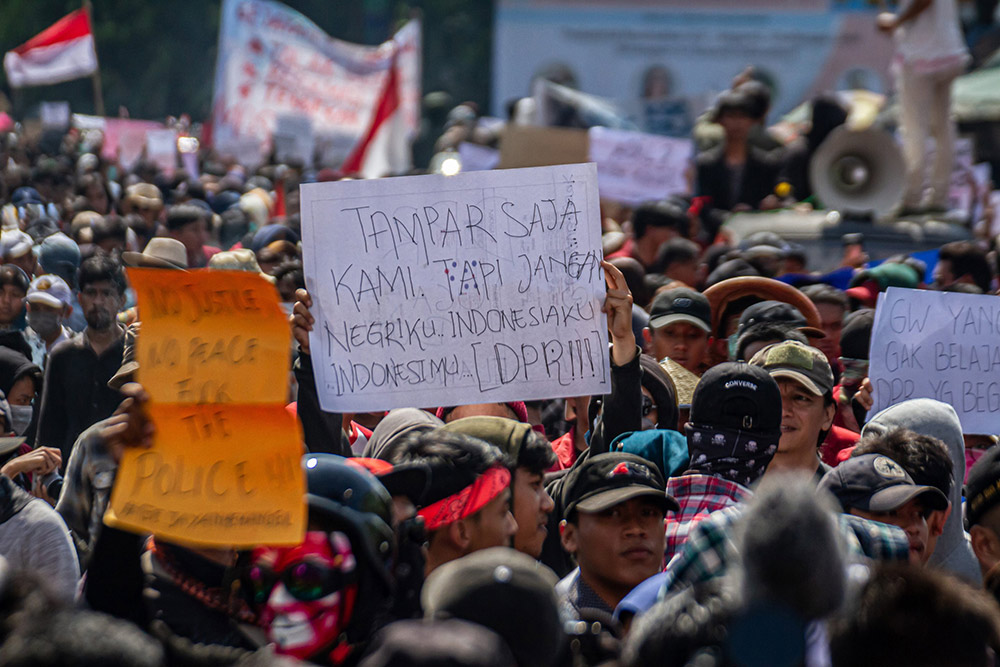
在21世紀的前十年,有一家亞洲跨國公司的首席執行官告訴我,他有全世界最好的工作。他只需要關注區域GDP和貿易增長預測,并且他可以預見自己的公司來年一定會生意興隆。他也不需要像其他地區的公司領導人一樣,需要關注政治和社會風險。他信誓旦旦地說,亞洲地區的轉變勢頭是不可阻擋的:亞洲局勢穩定,政策制定者正在積極推行實用的自由市場政策。
時間來到2021年。亞洲經濟依舊在快速增長,但一些問題卻令人堪憂。日益加劇的社會不平等,讓亞洲的年輕人感覺與父輩相比,他們的經濟機會將變得越來越少。
新冠疫情及其產生的公共衛生和經濟影響,讓亞洲面臨更嚴峻的考驗。中國、韓國、新加坡和越南等國家在防疫方面表現出色,但印度、印尼和菲律賓等所謂民主國家的表現卻非常糟糕。
亞洲從新冠疫情中復蘇的過程是一個自省的過程。我們看好的亞洲地區的未來前景,有多少是真實的呢?在新冠疫情之前,“前景光明的亞洲”成為主流敘事,有一小部分自鳴得意的亞洲精英聲稱,21世紀將是亞洲的世紀,但他們對亞洲面臨的嚴峻挑戰卻避而不談。
新冠疫情加劇問題。國際貨幣基金組織(IMF)的喬納森?奧斯特里曾經表示,亞洲的經濟產出大幅下降,年輕人和女性就業前景黯淡,可能留下“嚴重的創傷”。
與自然災害和金融危機一樣,新冠疫情給亞洲留下了長期無法愈合的傷疤。在社會遭到重大破壞的時期,亞州政府強有力的領導力將是解決潛在問題的關鍵。
亞洲還要密切關注日益加劇的社會不平等和社會階層固化,因為有數以億計的民眾正在努力躋身中產階級。目前對于亞洲中產階級規模的估算被嚴重夸大,絕對沒有達到世界經濟論壇(World Economic Forum)幾年前預測的驚人的17.5億人。這是因為評論家們使用經濟增長率來估算中產階級的規模,這種方法并不準確。
事實上,亞洲有大量貧困人口和中低收入勞動者,這些底層民眾向上攀登經濟階梯變得越來越難。亞洲高等教育的普及導致大學生過剩,就業前景黯淡。泰國、緬甸等地區發生的抗議,雖然主要誘因是本地的政治局勢,但它們有一個共同點,就是失業和就業不足的學生走上了街頭。新冠疫情的影響也暴露出亞洲城市貧困人口的困難處境。他們主要從事建筑、生產和家政等較為辛苦的工作。
氣候變化將增加亞洲城市社區的壓力,例如南亞和東南亞的溫度上升和洪水,正在迫使更多農村人口向城市遷移。
印度早在新冠疫情爆發之前就已經問題不斷,現在它只有改變偏向于億萬富翁階層的策略,才能夠恢復快速增長。越南雖然被視為亞洲經濟增長的榜樣,但它要想維持經濟增長,必須從根本上調整經濟結構,減少對本地巨頭和國有企業的依賴。
我們只有消除這些隱患,才可以向世人宣告“亞洲的世紀”已經來臨。(財富中文網)
本文作者瓦蘇基?沙斯特里現任英國皇家國際事務研究所(Chatham House)亞洲研究員。沙斯特里曾經是一名記者,曾經在國際貨幣基金組織、渣打銀行(Standard Chartered Bank)和新加坡央行長期任職。他是《亞洲已經走向衰敗?》(Has Asia Lost It? Dynamic Past, Turbulent Future)一書的作者。
翻譯:劉進龍
審校:汪皓
在21世紀的前十年,有一家亞洲跨國公司的首席執行官告訴我,他有全世界最好的工作。他只需要關注區域GDP和貿易增長預測,并且他可以預見自己的公司來年一定會生意興隆。他也不需要像其他地區的公司領導人一樣,需要關注政治和社會風險。他信誓旦旦地說,亞洲地區的轉變勢頭是不可阻擋的:亞洲局勢穩定,政策制定者正在積極推行實用的自由市場政策。
時間來到2021年。亞洲經濟依舊在快速增長,但一些問題卻令人堪憂。日益加劇的社會不平等,讓亞洲的年輕人感覺與父輩相比,他們的經濟機會將變得越來越少。
新冠疫情及其產生的公共衛生和經濟影響,讓亞洲面臨更嚴峻的考驗。中國、韓國、新加坡和越南等國家在防疫方面表現出色,但印度、印尼和菲律賓等所謂民主國家的表現卻非常糟糕。
亞洲從新冠疫情中復蘇的過程是一個自省的過程。我們看好的亞洲地區的未來前景,有多少是真實的呢?在新冠疫情之前,“前景光明的亞洲”成為主流敘事,有一小部分自鳴得意的亞洲精英聲稱,21世紀將是亞洲的世紀,但他們對亞洲面臨的嚴峻挑戰卻避而不談。
新冠疫情加劇問題。國際貨幣基金組織(IMF)的喬納森?奧斯特里曾經表示,亞洲的經濟產出大幅下降,年輕人和女性就業前景黯淡,可能留下“嚴重的創傷”。
與自然災害和金融危機一樣,新冠疫情給亞洲留下了長期無法愈合的傷疤。在社會遭到重大破壞的時期,亞州政府強有力的領導力將是解決潛在問題的關鍵。
亞洲還要密切關注日益加劇的社會不平等和社會階層固化,因為有數以億計的民眾正在努力躋身中產階級。目前對于亞洲中產階級規模的估算被嚴重夸大,絕對沒有達到世界經濟論壇(World Economic Forum)幾年前預測的驚人的17.5億人。這是因為評論家們使用經濟增長率來估算中產階級的規模,這種方法并不準確。
事實上,亞洲有大量貧困人口和中低收入勞動者,這些底層民眾向上攀登經濟階梯變得越來越難。亞洲高等教育的普及導致大學生過剩,就業前景黯淡。泰國、緬甸等地區發生的抗議,雖然主要誘因是本地的政治局勢,但它們有一個共同點,就是失業和就業不足的學生走上了街頭。新冠疫情的影響也暴露出亞洲城市貧困人口的困難處境。他們主要從事建筑、生產和家政等較為辛苦的工作。
氣候變化將增加亞洲城市社區的壓力,例如南亞和東南亞的溫度上升和洪水,正在迫使更多農村人口向城市遷移。
印度早在新冠疫情爆發之前就已經問題不斷,現在它只有改變偏向于億萬富翁階層的策略,才能夠恢復快速增長。越南雖然被視為亞洲經濟增長的榜樣,但它要想維持經濟增長,必須從根本上調整經濟結構,減少對本地巨頭和國有企業的依賴。
我們只有消除這些隱患,才可以向世人宣告“亞洲的世紀”已經來臨。(財富中文網)
本文作者瓦蘇基?沙斯特里現任英國皇家國際事務研究所(Chatham House)亞洲研究員。沙斯特里曾經是一名記者,曾經在國際貨幣基金組織、渣打銀行(Standard Chartered Bank)和新加坡央行長期任職。他是《亞洲已經走向衰敗?》(Has Asia Lost It? Dynamic Past, Turbulent Future)一書的作者。
翻譯:劉進龍
審校:汪皓
During the 2000s, a multinational CEO based in Asia told me he had the best job in the world. All he had to do was look at regional GDP and trade growth projections, and he could surmise that his business was destined for another blockbuster year. Nor did he need to worry about political and social risks, unlike his counterparts elsewhere. He assured me that the region’s transformation was unstoppable: Asia was stable and policymakers were enthusiastically pursuing pragmatic free market policies.
Fast forward to 2021. Asia still has high rates of economic growth, but social and political stability is fraying. Rising inequality has left younger Asians feeling that economic opportunity will be narrower compared with the booming generation of their parents.
The COVID-19 pandemic, and its public health and economics effects, has further tested the region. There are winners in China, Korea, Singapore and Vietnam, and countries that have stumbled, including storied democracies like India, Indonesia and the Philippines.
Asia’s emergence from the COVID-19 pandemic is a time for introspection. How much of what we boastfully declared about the region’s prospects is for real? Before the pandemic, an “Asia Shining” narrative dominated discourse as a small group of self-satisfied regional elites declared the 21st Century to be an Asian century, glossing over much of the region’s profound economic, social, and political challenges.
The problems were turbocharged by COVID-19. As the IMF’s Jonathan Ostry noted, Asia saw unprecedented declines in output and diminished job prospects for youth and women—and that “significant scarring” was likely.
Pandemics, like natural disasters and financial crises, leave long-lasting scars. Strong leadership from Asian governments will be critical in tackling fault lines.
Asia also need to pay attention to rising inequality and stalling social mobility, as hundreds of millions struggle to rise to the ranks of the middle class. Current estimates about the size of Asia’s middle class are vastly exaggerated—certainly not near the astonishing 1.75 billion that the World Economic Forum projected a few years ago—as commentators incorrectly use rates of economic growth to estimate the size of the middle class.
Instead, Asia has a vast army of poor and low-to-middle-class toilers who are finding that climbing the economic ladder is not as easy as it was in the past. The spread of higher education across Asia has created a surplus of college graduates with limited job prospects. Protests across Asia, such as those in Thailand, Myanmar and elsewhere—though driven by local political developments—have a common thread in unemployed and underemployed students taking to the streets. The fallout from the COVID-19 pandemic has also exposed the depredations of Asia’s urban poor. They toil in sectors like construction, manufacturing, and domestic labor.
Climate change will only increase pressures on urban Asian communities, as rising temperatures and flooding in South and Southeast Asia are forcing ever higher rates of emigration from rural communities.
India, which stumbled even before the pandemic, needs to transfer incentives away from the billionaire class if it is to return to high growth. Even Vietnam—the current poster child of a growing Asia—cannot hope to progress without a radical restructuring of the economy away from preferred local tycoons and state enterprises.
We cannot continue to gloss over these fault-lines in our rush to declare that an "Asian Century" has arrived.
Vasuki Shastry is an Associate Asia Fellow at Chatham House. A former journalist, he had a long career at the International Monetary Fund, Standard Chartered Bank, and Singapore’s central bank. He is the author of “Has Asia Lost It? Dynamic Past, Turbulent Future”.






